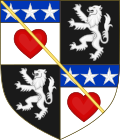William Douglas of Nithsdale facts for kids
Sir William Douglas of Nithsdale (around 1370 – 1391) was a brave Scottish knight and a Crusader who fought in the Baltic region.
Contents
Early Life of a Knight
William Douglas was the son of Archibald the Grim, 3rd Earl of Douglas. His mother is not known.
William was known for being dashing and brave. In 1385, he was with the Scottish and French army that tried to capture Carlisle Castle in England. Even though they didn't succeed, William showed great courage. He was known for his brave actions and for fighting many English soldiers. People said he was always busy, whether by sea or land, trying to harm his enemies, and they feared him greatly.
A Royal Marriage
By 1387, William Douglas had proven himself worthy of being a knight. He married Egidia Stewart, who was a Princess of Scotland and the daughter of King Robert II.
Princess Egidia was famous for her beauty. Even Charles V of France had sent a painter to capture her looks, hoping to marry her! But William Douglas, with his knightly charm, won her heart instead. As part of their marriage, William received lands in Nithsdale in Scotland, Herbertshire, and a yearly payment of £300.
Adventures in Ireland
Within a year of his marriage, William led a trip to stop Irish raiders who were causing trouble for people living on his father's lands in Galloway. In the early summer of 1388, he sailed into Carlingford Lough with 500 well-trained soldiers.
They landed near the town of Carlingford and called for the local leaders. The townspeople offered money for a short break in fighting, and William agreed. But secretly, the townspeople sent for help from Dundalk. About 800 spearmen from Dundalk surprised the Scottish camp at night, and people from Carlingford town also attacked.
However, the Scottish soldiers were experienced in tough border battles. They fought off the Irish, captured the town, and burned it. They also took the castle and seized 15 ships in the harbor. On their way back to Scotland, William's forces also caused damage and took supplies from the Isle of Man. They returned to Loch Ryan just in time to join in raids on Northern England, which led to the famous Battle of Otterburn on August 19. William fought very well in this battle.
Crusading and Final Days
The year after the Battle of Otterburn, Scotland and England agreed to a truce. William Douglas, seeking more glory as a knight, decided around 1389 to join the Teutonic Knights. These knights were fighting against the Lithuanians in the Baltic region.
William had a rivalry with Lord Clifford, whom he had faced before at Carlisle. It's said that while both were abroad, Clifford challenged William to a one-on-one fight. William even went to France to get special armor for this duel. However, Clifford died on August 18, 1391.
William Douglas still went to their agreed meeting place. While walking on a bridge leading to the main gate in Danzig (now Gdańsk, Poland), he was sadly "killed by the English."
The people of Danzig had a special respect for the Douglas family. They remembered how the Douglas family had once helped their city greatly against the Poles. Because of this, Scottish people were allowed to become free citizens of Danzig. For centuries, the stone front of the Hohe Thor (High Gate) in Danzig was decorated with William Douglas's coat of arms. It was even called the Douglas Port or Douglas Gate as late as 1734.
Family
William Douglas and Princess Egidia had two children:
- Egidia Douglas, who was known as the "Fair Maid of Nithsdale." She married:
-
- 1. Henry Sinclair, 2nd Earl of Orkney (died 1422)
- 2. Sir Alasdair Stewart (executed 1425), who was the son of Murdoch Stewart, 2nd Duke of Albany
- Sir William Douglas, Lord of Nithsdale (died around 1419). He became a knight when he was very young. He was called a chevalier (knight) in a document from January 30, 1406, when he couldn't have been older than nineteen.


